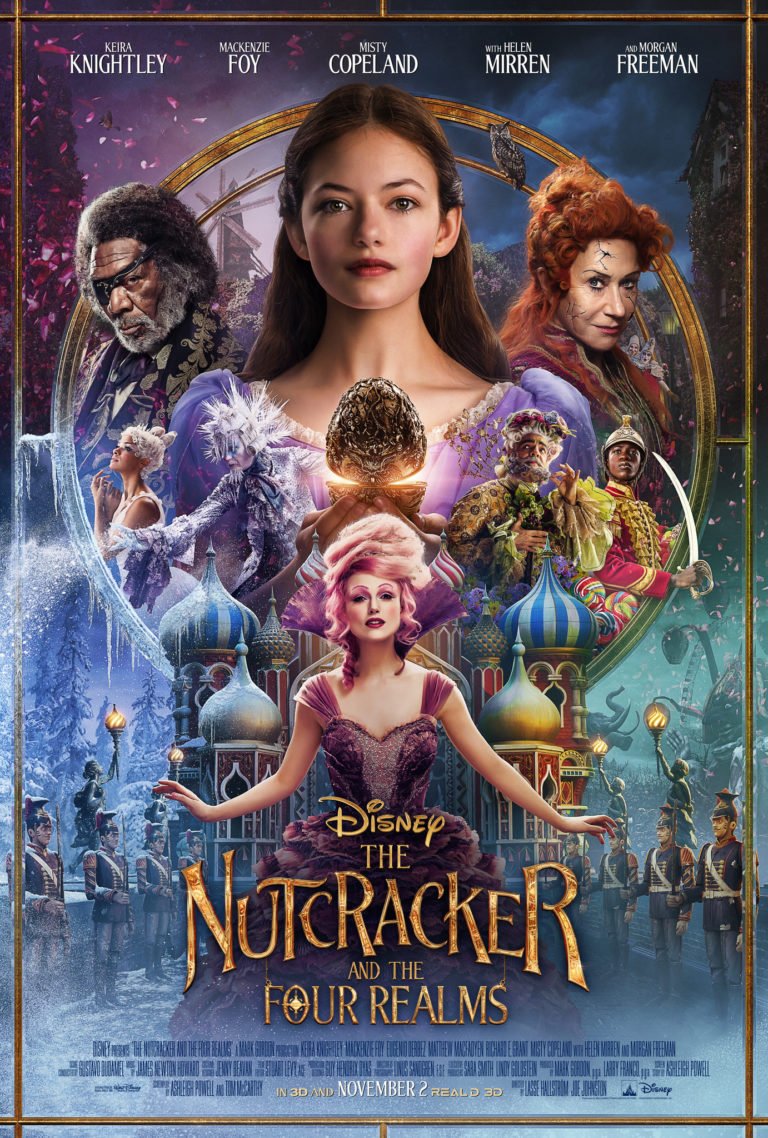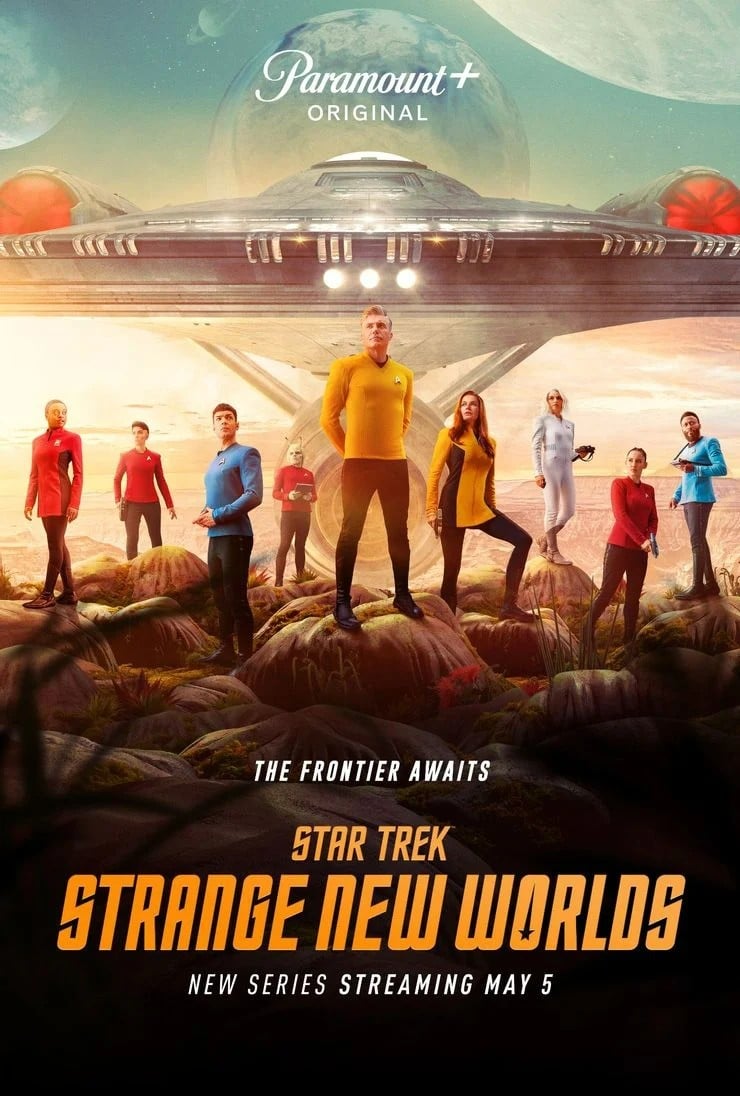“STAR TREK Makes a Comeback”

| None | Light | Moderate | Heavy | |
|---|---|---|---|---|
| Language | ||||
| Violence | ||||
| Sex | ||||
| Nudity |
What You Need To Know:
The first four episodes of STAR TREK: STRANGE NEW WORLDS are the closest to the original STAR TREK series Paramount has made. They capture the fun and idealism of the original series. Except for implied sexual situations in one episode and light foul language in two episodes, they are clean, family-friendly productions. Also, they have a mixture of moral, humanist and sometimes redemptive messages. The fourth episode is the best, most redemptive episode. MOVIEGUIDE® advises caution for older children for STAR TREK: STRANGE NEW WORLDS.
Content:
A humanist, utopian worldview overall favoring a globalist attitude with some occasional socialist leanings, but often mitigated by strong moral elements and, sometimes, by some solid redemptive elements with biblical allusions such as the main hero says, “The best miracles are born from truth” in Episode 1.4
Seven obscenities (five “h” words and two “d” words) and no profanities in Episode 1.1, no foul language in Episode 1.2, five obscenities and no profanities in Episode 1.3, and one “h” obscenity in Episode 1.4
Strong and light, sometimes scary, action violence in first four episodes such as a military team fights to free crew members of spaceship who’ve been kidnapped, a huge ion storm threatens two men on a planet and spaceship above planet, crew members are infected by a genetically induced sickness from planet, colonists trying to reverse their illegal genetic modifications have been transformed into scary energy beings, a weapon blasts a makeshift connecting tunnel between two spaceships, and intense spaceship battles occur between the good guys and a race of mysterious and ruthless aliens who are said to eat their prey, including humans
Two implied fornication scenes in Episode 1.1 but no sexual content in Episodes 1.2, 1.3, 1.4
Upper male nudity in two scenes in Episode 1.1, but no nudity in Episodes 1.2, 1.3, 1.4
Brief alcohol use in Episode 1.2
No smoking or drugs; and,
Some misguided aliens kidnap crew members in the first episode, the Enterprise crew misjudges a race of mystical aliens with strong religious beliefs but learns a lesson about bigotry and undue prejudice, doctor on spaceship is harboring a secret that has endangered its crew.
More Detail:
Of course, up to now, both the original series and its progeny always made it clear that science could be used for evil purposes, and that highly advanced computer systems could go haywire. However, they’ve always shown how humans could use science and technology to better the lives of people. Thus, even crime is eliminated using science, as in one episode in the original series where the criminally insane are treated medically. That said, the original series repeatedly made the point that human beings should apply wisdom, logic and moral tradition to resolve conflicts and fix problems. In many episodes in the original series, for instance, Captain Kirk saved the day by combining the cold logic of his science officer, Mr. Spock, with the intuitive morality and emotional conscience of Dr. McCoy. The first six STAR TREK movies continued these themes, with THE WRATH OF KHAN being a high point where biblical, redemptive themes took precedence, and the movie concluded with a highly moving instrumental rendition of “Amazing Grace” near the end, followed by an eloquent speech by Captain Kirk about hope and new life.
In the next series, THE NEXT GENERATION, utopian humanism became even more prominent in the STAR TREK universe. A new twist was added, however. New Age, alien religions were often lauded, with traditional, ethical monotheism coming under attack, or ignored altogether. At times in the series, and in the other STAR TREK programs that followed, it seemed as if a person could have any religion but Judaism, Islam and especially Christianity. This attitude became stronger in the next series, DEEP SPACE NINE. IN DS9, the space station depicted in the series, protected a planet, Bajor, and where the Bajorans invited the United Federation of Planets to help them administer the space station and protect it from aggressive alien species like the Klingons, the Romulans and especially the Cardassians, a race of reptile-like humanoids. The Bajorans had an alien religion where they worshipped god-like beings they called “the Prophets.” The series often attacked religious “fundamentalists.” Thus, a major villain who appeared from time to time in the series was a Bajoran fundamentalist played by Louise Fletcher, who won an Oscar playing Nurse Ratched in the movie version of ONE FLEW OVER THE CUKOO’S NEST.
The next two STAR TREK series, VOYAGER and ENTERPRISE, are fairly innocuous. Exploring space and battling aliens through science and technology are the main focus. After Paramount canceled the ENTERPRISE series prematurely in 2005, the STAR TREK franchise went on a four-year hiatus. Then, in 2009, Paramount released a reboot of the original series by revisioning a universe where Captain Kirk’s father had died shortly after he was born. The three movies produced in this reboot from 2009 thru 2016 are more like science fiction adventures with good guys and bad guys rather than missions of space exploration.
In 2017, however, Paramount released a new series, titled STAR TREK: DISCOVERY, set 10 years before Captain Kirk took command of the Enterprise. DISCOVERY is the most politically correct, “woke” series of all. Although there are one or two significant heterosexual relationships, two major characters, the head engineer and the doctor, are homosexual lovers. Then, in the last two seasons, the series introduced a transgender character.
The new STAR TREK series, STRANGE NEW WORLDS, is a prequel to the original series. Christopher Pike, the second Captain of the Enterprise before James Kirk, starts an exploration of deep space for the United Federation of Planets, where the Enterprise crew faces various life or death situations in outer space and meets worse or more beautiful beings. The first four episodes of STAR TREK: STRANGE NEW WORLDS are the closest thing to the original series that Paramount has made yet. They have a mixture of moral, humanist and sometimes redemptive messages and more family-friendly content. The first episode, however, sends a generally utopian, politically correct, globalist message about handling social upheaval and political conflict. It also has two scenes of implied sex.
In the first episode, Captain Pike is reluctant to return to the Enterprise, because his encounter with a “time crystal” at Klingon religious monastery when he was captain of the Discovery gave him a vision of the tragic accident he suffers seven years in the future that will paralyze his whole body. However, here, he’s compelled to return as Captain because his first officer, Una, has been kidnapped by people on a planet engaged in a global war.
Captain Pike learns the global war is similar to the one that almost destroyed Earth in the 21st Century. The people who kidnapped Una have accidentally reverse engineered Federal warp technology after seeing the Discovery spaceship. However, they have decided to turn the technology into a weapon to destroy their enemy. They kidnapped Una and some other crew members when they tried to stop them from developing the weapon. Now, Pike must rescue the crew members and convince the people that the global war they are waging could destroy their planet.
In the second episode, the Enterprise tries to stop a comet from smashing into an inhabited planet. The crew discovers the comet has a force field! Upon further investigation, they find that the comet is actually an artifact with a hollow center. Cadet Uhuru must use her communications, language skills to help Spock turn off the force field so that the Enterprise can steer the comet away from the endangered planet.
However, another starship appears and interposes itself between the comet and the Enterprise. The beings on the starship inform Captain Pike that the comet is a supernatural being that is an arbiter of life and death. They say they are shepherding the comet through space and, if it destroys the planet, that destruction will be a sacred, ordained inevitability. Of course, Pike and the other Enterprise crew members don’t accept such metaphysical thinking. In the end, however, they are forced to reconsider their judgmental reaction as they learn more about the artificial intelligence behind the artifact inside the comet.
In the third episode, the crew investigates the disappearance of a colony of genetically modified humans called the Illyrians. Starfleet on Earth has always banned genetic modifications of humans because of the genetic war in the 21st Century that nearly destroyed humanity. However, the Illyrian colony is trying to reverse their genetic modifications so they can join the Federation.
Captain Pike has beamed down to the colony with some crew members to investigate the Illyrian’s disappearance. A terrible ion storm approaches the colony, however, and Pike and Mr. Spock get stranded. Also, the Illyrians have accidentally created a virus that causes humans to be addicted to light. The virus threatens to render the Enterprise crew unable to save Pike and Spock’s life.
The fourth episode begins with the Enterprise trying to deliver a powerful air filter to a Federation colony. However, when they arrive, they find that many of the colonists have been killed.
Security Officer La’an Noonien-Singh, a distant descendent of the infamous Khan, helps rescue the survivors and recognizes they are the victim of an attack by the Gorn, a mysterious, ruthless race of aliens. She warns Captain Pike, but the Gorn arrive in some spaceships and seriously damage the Enterprise. To make matters worse, a large Gorn mothership arrives. The Enterprise is clearly no match for the Gorn.
So, Pike orders a retreat into the dense atmosphere of a dying star near a black hole. Can he lure the Gorn ships into the star’s dense atmosphere, where both sensors and shields are useless and where Enterprise can be on more of an equal footing?
The first four episodes of STAR TREK: STRANGE NEW WORLDS are the closest to the original STAR TREK series that Paramount has made yet. They capture the fun and heroic idealism of the original series. Except for some implied sexual situations in one episode and light foul language in two episodes, they clean, family-friendly productions.
The four episodes have a mixture of moral, humanist and sometimes redemptive messages. The fourth episode is the best, most redemptive episode. It has some biblical allusions. Also, at one point, Captain Pike says, “The best miracles are born from truth.” The first episode, however, sends a generally utopian, politically correct, globalist message about handling social upheaval and political conflict. In the episode, Captain Pike explains to the warring faction on the planet with stolen Federation technology that, in the 21st Century, Earth was like them. It had two warring factions with contrary, irreconcilable beliefs. The global war between the two factions badly damaged the Earth and nearly destroyed all life on the planet. Eventually, Pike convinces the two factions to make peace, but he scares them to do it. The first episode seems like an idealistic, humanist commentary on the fight between Republicans and Democrats in America today. Of course, the writers of this episode never consider the possibility that, perhaps, one faction is mostly right and good and the other faction is mostly wrong or evil. All-out nuclear war is not a solution in situations like this, but neither is complete surrender of one’s principles.
MOVIEGUIDE® advises caution for older children for the first four episodes of STAR TREK: STRANGE NEW WORLDS because of intense violence and peril, brief foul language, and two sexual situations in one episode. Potential viewers should also be warned that there’s no guarantee the remaining six episodes planned for Season One won’t contain more of the same, or worse.


 - Content:
- Content: 




